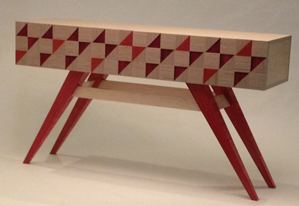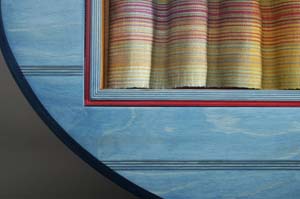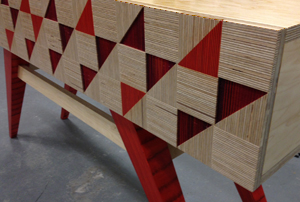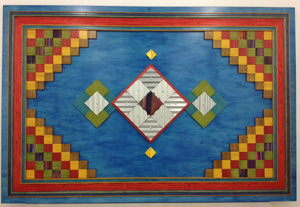
The same dye that colors Anne Bossert’s textiles brings stunning color to birch, maple, and other woods she uses. (Photo by A. Bossert)
When I started planning “Handmade on the Front Range,” I wondered what I would say about artisans who work with wood. That’s a “guy thing,” right? Bulky equipment, saws, sawdust . . . What would interest female readers?
One of the joys of meeting artisans and learning about their work is having my preconceived ideas blown away. That’s what happened when I met Anne Bossert, fiber artist and furniture maker, on the Fort Collins Studio Tour.
Anne’s studio lies on the northeast side of Fort Collins, in one of the practical, no-nonsense-looking buildings a few blocks north of Mulberry Street. Not exactly the place where I would expect someone with artistic sensibilities to hang out.
Any skepticism evaporated the moment I walked inside. At the far end of Anne’s meticulously cleaned workshop stood three tables that made me gasp. Let me show you why.
What You See with a Closer Look
Design and color make Anne’s tables striking, for sure; but it’s the quality of the color that took my breath away. Anne reformulates the dye that she uses on cotton fiber to make a wood stain. The result: visible wood grain.

Textile and wood come together in Anne Bossert’s furniture. Glass protects her handwoven cotton textile and makes this tabletop functional. (Photo by Joe Mendoza)
I assumed that she had used dark blue paint to add sets of thin stripes to the tabletop you see to the left. No, Anne told me – that’s the same stain on inlaid plywood.
Inlaid plywood? Really?
Plywood has little status around our house. It warps. It looks unfinished on the ends. But it’s those unfinished ends – visible layers of wood and glue – that give Anne’s furniture what I would call her signature stripe. Anne knows where to find quality plywood that won’t give her trouble, too; so every part of her tables is plywood.
Another of my preconceived ideas blown away . . .
Anne buys her plywood from Sears Trostel. It carries varieties you can’t buy at major chains, she told me. Her current favorite: maple. Its hardness keeps the dye from soaking in too fast and gives her control over how the wood accepts color.

Pieces of birch plywood glued together form the striped squares and striped legs on this table by Anne Bossert. (Photo provided by A. Bossert)
When she needs a thick piece of wood for table legs, Anne glues pieces of plywood together. Two sides of the resulting post still show natural wood grain.
By the time she finishes tapering the legs, though, stripes appear on all sides. To see what I mean, look carefully at the table legs in this close-up photo.
Incidentally, the colorful triangles in the photo on the left are a mix of stained plywood and Anne’s handwoven textile.
How a Fiber Artist Becomes a Furniture Maker
Anne became interested in making furniture while she was studying fiber arts in the Master of Fine Arts program at Colorado State University in the early 2000’s. She created a piece of fabric that was so beautiful, she wanted to do something with it that would make it more than just another piece of cloth … something that would give it real status.
After learning that the same dyes she used for cotton and silk could stain wood, Anne decided to use furniture to showcase her textiles.
CSU has a woodshop used primarily by sculpture students. But Bruce Davidson, the woodshop coordinator at the time, taught her the basics of making furniture. From there she taught herself out of a book by Gary Rogowski – The Complete Illustrated Guide to Joinery.
So much for woodworking being “a guy thing.” Yet another preconceived idea blown away — to my delight.
No doubt Anne is pleased too. She admitted that an inner urge to show that women can do whatever they want kept her making furniture through times of self-doubt.
Where Scraps Become Art

Anne Bossert pulled together scraps of plywood cross-sections and textiles to create this wall hanging. (Photo by A. Bossert)
Anne saves her scraps of wood and textiles and tries to use them in creative ways. This wall hanging is one of the results. To see the detail of the textile and plywood cross-sections she used, take a look at this month’s cover photo on the Facebook page of “Handmade …”.
While you’re there, why not check the recent posts to find out if the content is something you enjoy. Don’t forget to “like” the page if you do.
Do you know of another artisan who does amazing things with scraps? Or an artisan you think is just plain amazing? Click “leave a reply” at the top of this page and share what you know.
View more of Anne’s work at annebossertart.com. Use her contact page to receive information from Anne about prices, availability, and custom projects.
Sally, I’m so glad you showcased Anne’s work. I am thrilled to own a piece of hers! I had seen an exhibit of Anne’s years ago and remembered her when we moved to Fort Collins. We commissioned a two-piece coffee table last year and it absolutely MAKES our living room. She’s also a delight to work with.
I’ll be following your blog for exposure to more wonderful artists. Thank You.
Yes, Anne is a delight to work with. Thank you for your enthusiastic response.
Another interesting and informative topic.
Thanks, Carol. I plan to keep them coming.